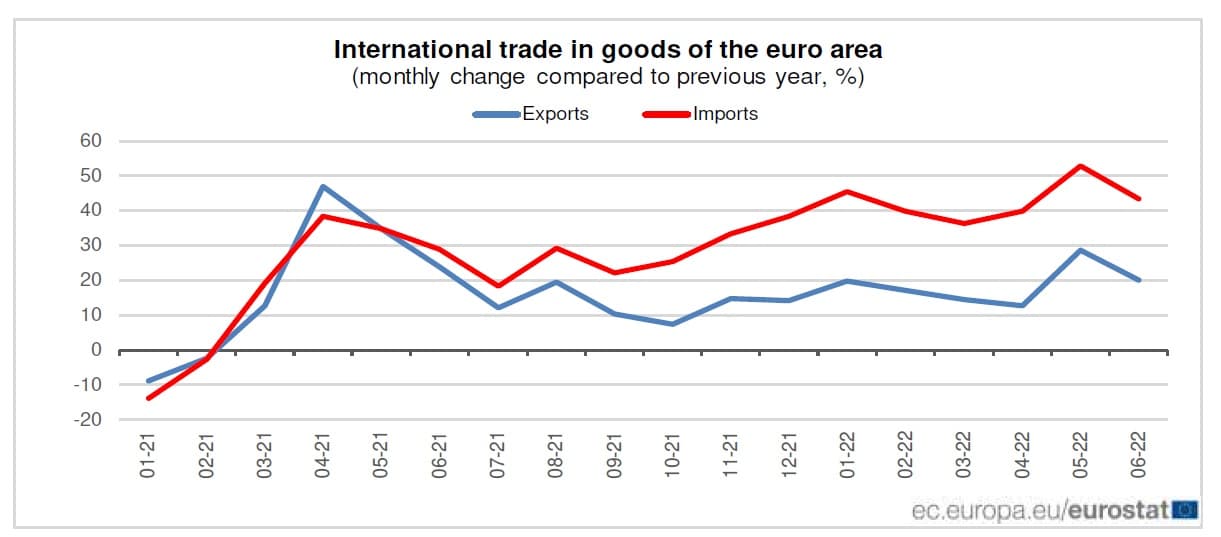(CN) — Driven by its rising energy costs, the eurozone saw another trade deficit in June, the eighth straight month its imports outpaced its exports, according to European Union data released Tuesday.
The economies of the eurozone’s 19 nations - those that use the euro as their official currency - and the other countries that make up the 27-member EU were heavily dependent on Russian natural gas before Russia invaded Ukraine in February.
But now that Russia has reduced the flow of gas in Nord Stream I, its main pipeline to Europe, to 20% of its capacity in response to Western sanctions, gas prices have spiked and EU leaders are urging residents across the bloc to conserve electricity, some of which is produced by gas-fired power plants, to help build up gas reserves for winter.
The quagmire comes amid blistering summer heat, rampant wildfires and a drought in Europe that one expert has predicted could be its worst in 500 years.
The eurozone’s trade deficit reflects its efforts since the Russia-Ukraine war started to replace Russian gas with imports from the United States, Algeria, Azerbaijan, Qatar, Egypt and Norway.
The eurozone recorded a 24.6 billion euro ($25 billion) trade deficit with the rest of the world in June 2022, compared to a 17.2 billion euro ($17.5 billion) surplus in June 2021, according to data released Tuesday by Eurostat, the European Union’s statistics agency.
For the first six months of 2021, the eurozone had a surplus of 100.6 billion euros ($102.3 billion), while for those months this year its trade fell to a 140.4 billion euro ($142.7 billion) )deficit.
The EU as a whole saw a similar turn of fortunes, going from a trade surplus of 83.2 billion euros ($84.6 billion) for January to June 2021 to a 200.7 billion euro ($204.1 billion) deficit over the same stretch this year.
The main cause of the deficits was energy purchases, according to Eurostat.
In the first six months of 2022, the EU recorded a 290.8 billion euro ($295.7 billion) trade deficit in energy, up from 105.6 billion euros ($107.4 billion) from January to June 2021.
Despite the gloomy outlook, there were some bright spots in Eurostat’s report.
The EU’s exports of goods to the United States rose 29% – the most among its top trading partners – in the first half of the year, thanks to strong sales of chemicals, machinery and vehicles.
Germany, the bloc’s wealthiest nation and its economic lynchpin, saw a 33 billion euro ($33.5 billion) trade surplus from January to June.
But experts say more trouble is the horizon for the EU due to the extreme heat and drought roiling Europe.
EU wheat and barley production is expected to fall 5% and 1%, respectively, compared to last year, according to Janusz Wojciechowski, the EU commissioner for agriculture.
“Maize [corn] harvest will only start in autumn but given the ongoing drought conditions yields are expected to be well below long-term average,” Wojciechowski wrote Tuesday on Twitter.
With the shortages forcing EU farmers to pay higher prices for grains to feed their livestock, while they are also facing higher energy costs, disease outbreaks and labor shortages, economists say European consumers will feel it at the supermarket with price spikes for meat, milk and cheese.
Subscribe to Closing Arguments
Sign up for new weekly newsletter Closing Arguments to get the latest about ongoing trials, major litigation and hot cases and rulings in courthouses around the U.S. and the world.









